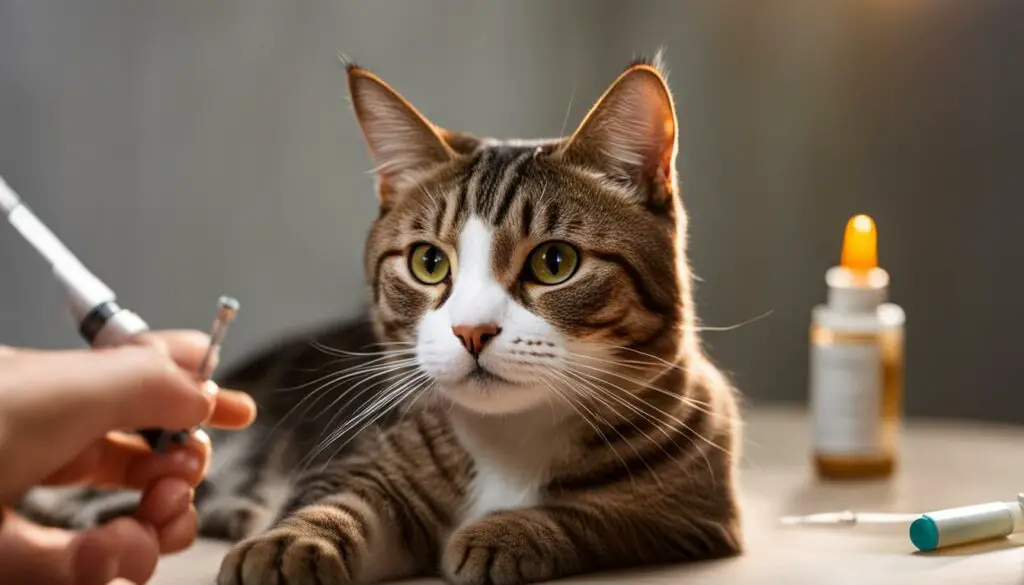Giving insulin to a cat with diabetes can be challenging, especially when it comes to timing. Many cat owners wonder if they can give their cat insulin 2 hours early. We will explore the factors to consider and guidelines for administering insulin to cats.
In this section, we will discuss the importance of understanding insulin treatment for feline diabetes and the potential risks of giving insulin too early. We will also provide guidelines for insulin timing in cats and tips for administering insulin to cats. Additionally, we will cover the considerations when giving insulin early and the importance of regular monitoring and communication with the veterinarian.
Key Takeaways:
- Administering insulin to cats with diabetes requires careful consideration of timing and following the recommended schedule.
- Giving insulin to a cat too early can lead to hypoglycemia, a condition characterized by low blood sugar.
- It is generally recommended to administer insulin injections to cats twice a day, approximately 12 hours apart.
- Adjusting the insulin schedule for cats should always be done under the guidance of a veterinarian.
- Proper management of feline diabetes involves regular communication with the veterinarian, monitoring blood glucose levels, and maintaining a consistent treatment plan.
Understanding Insulin Treatment for Feline Diabetes
Administering insulin to cats is a crucial part of managing feline diabetes. Proper understanding of insulin treatment is key to maintaining stable blood glucose levels in cats with diabetes. When it comes to cat insulin administration, timing is of utmost importance.
Insulin doses for cats are typically given twice a day, approximately 12 hours apart. This schedule helps regulate blood sugar levels and prevents hypo- and hyperglycemia. It is important to follow the recommended insulin timing for cats to ensure effective diabetes management.
“Proper insulin administration is essential for maintaining stable blood glucose levels in cats with diabetes.”
However, there might be situations where cat owners wonder if they can give their cat insulin 2 hours early. While it is generally recommended to stick to the prescribed schedule, there may be instances when early insulin doses are necessary. In such cases, it is crucial to consult with a veterinarian to determine the appropriate action based on the cat’s individual health needs.
| Pros | Cons | |
|---|---|---|
| Early Insulin Doses |
|
|
Ultimately, the decision to give a cat insulin early should be made in consultation with a veterinarian. They will assess the cat’s specific condition and provide guidance on adjusting the insulin schedule if necessary. Regular communication with the veterinarian is essential for optimizing the cat’s diabetes management and overall well-being.
The Risks of Giving Insulin Too Early
Giving insulin to a cat too early can have serious consequences and pose risks to their health. One of the main risks is the development of hypoglycemia, a condition characterized by low blood sugar levels. Hypoglycemia can lead to weakness, lethargy, confusion, and even coma in cats. It is crucial to follow the recommended insulin schedule and avoid giving insulin doses ahead of time without consulting a veterinarian.
Adjusting the insulin schedule for cats should always be done under the guidance of a veterinarian. They will consider the cat’s individual needs and medical history in determining any necessary adjustments. Giving insulin to cats in advance without proper knowledge can disrupt the cat’s glucose control and potentially lead to imbalances in their blood sugar levels.
Regular communication with a veterinarian is essential for managing a cat’s insulin schedule effectively. The veterinarian will provide guidance on proper administration and timing of insulin doses, taking into account the cat’s response to treatment and any other relevant factors. By working closely with a veterinarian, cat owners can ensure the best possible care and management of their cat’s diabetes.
The Risks of Giving Insulin Too Early
| Risks | Description |
|---|---|
| Hypoglycemia | Giving insulin too early can lead to low blood sugar levels in cats, causing weakness, lethargy, confusion, and even coma. |
| Disrupted glucose control | Administering insulin doses ahead of time without proper guidance can disrupt a cat’s glucose control and lead to imbalances in blood sugar levels. |
Guidelines for Insulin Timing in Cats
Proper timing of insulin doses is essential for managing feline diabetes effectively. When it comes to giving insulin to cats, it is generally recommended to administer the injections twice a day, approximately 12 hours apart. This schedule helps maintain stable blood sugar levels and ensures that the cat receives consistent and timely doses of insulin.
Deviation from the recommended insulin timing can disrupt the cat’s glucose control and pose health risks. It is important to follow the guidelines provided by your veterinarian and avoid giving insulin doses earlier than scheduled without proper guidance. Consistency in insulin administration is key to managing feline diabetes and preventing complications.
While it may be tempting to give insulin to your cat earlier, especially if you are concerned about missed doses or fluctuations in their schedule, it is crucial to consult with a veterinarian before making any adjustments. They will consider your cat’s individual needs, medical history, and response to treatment to determine the best insulin timing for your furry friend.
Factors to Consider
When determining the appropriate insulin timing for your cat, several factors should be taken into account:
- The type of insulin being used
- The cat’s eating habits and meal schedule
- The cat’s activity level and exercise routine
- The cat’s overall health and any concurrent medical conditions
- The cat’s blood glucose levels and response to treatment
Taking these factors into consideration, your veterinarian will provide specific guidelines for insulin timing that are tailored to your cat’s needs. It is important to communicate any changes or concerns regarding your cat’s insulin administration with your veterinarian to ensure optimal feline diabetes management.
| Factors to Consider for Insulin Timing | Guidelines |
|---|---|
| Type of insulin | Follow manufacturer instructions and veterinarian’s recommendations |
| Cat’s eating habits and meal schedule | Administer insulin around mealtimes to coincide with glucose spikes |
| Cat’s activity level and exercise routine | Adjust insulin timing to accommodate exercise and prevent hypoglycemia |
| Cat’s overall health and concurrent medical conditions | Consider any medication interactions or health factors that may affect insulin timing |
| Cat’s blood glucose levels and response to treatment | Monitor glucose levels and adjust insulin timing as needed under veterinary guidance |
By following the recommended guidelines for insulin timing in cats, you can help ensure that your furry friend receives the appropriate amount of medication to effectively manage their diabetes and maintain their overall health and well-being.
Adjusting Insulin Schedule for Cats
When it comes to managing feline diabetes, adjusting the insulin schedule for cats may be necessary in certain situations. However, it is essential to do so under the guidance of a veterinarian who can provide personalized recommendations based on the cat’s individual needs and response to treatment.
Adjustments to the insulin schedule may involve changes in the timing of insulin doses or alterations in the dosage amount. This fine-tuning is crucial for maintaining stable blood glucose levels and ensuring effective diabetes management.
During the adjustment process, close monitoring of the cat’s blood glucose levels is necessary to evaluate the effectiveness of the new insulin schedule. Regular communication with the veterinarian is key, as they can provide guidance and make any necessary modifications to the treatment plan to achieve optimal results.

Factors to Consider when Adjusting Insulin Schedule for Cats
- The cat’s overall health and medical history
- The cat’s response to previous insulin treatments
- Blood glucose levels and patterns
- The cat’s weight and body condition
- Feeding schedule and diet
- Physical activity and exercise routine
- Potential stressors or changes in the cat’s environment
By considering these factors, the veterinarian can develop a tailored insulin schedule that meets the specific needs of the cat. It is important for cat owners to follow the veterinarian’s instructions closely and provide regular updates on the cat’s condition to ensure the best possible diabetes management.
Considerations When Giving Insulin Early
When it comes to administering insulin to cats with diabetes, following the recommended schedule is crucial. However, there may be situations where giving insulin early becomes necessary. It’s important to note that this should only be done under the guidance of a veterinarian, taking into account the cat’s individual needs and medical history.
Giving insulin to a cat ahead of time without proper consultation can disrupt their glucose control and pose health risks. The veterinarian will assess the cat’s response to treatment and provide appropriate recommendations. So, if you ever find yourself in a situation where giving insulin early is needed, make sure to reach out to your vet for guidance.
Remember, managing feline diabetes is a team effort between you and your veterinarian. Open communication, regular check-ups, and monitoring play a vital role in ensuring your cat’s well-being. By working together and following their guidance, you can provide the best care for your furry friend.
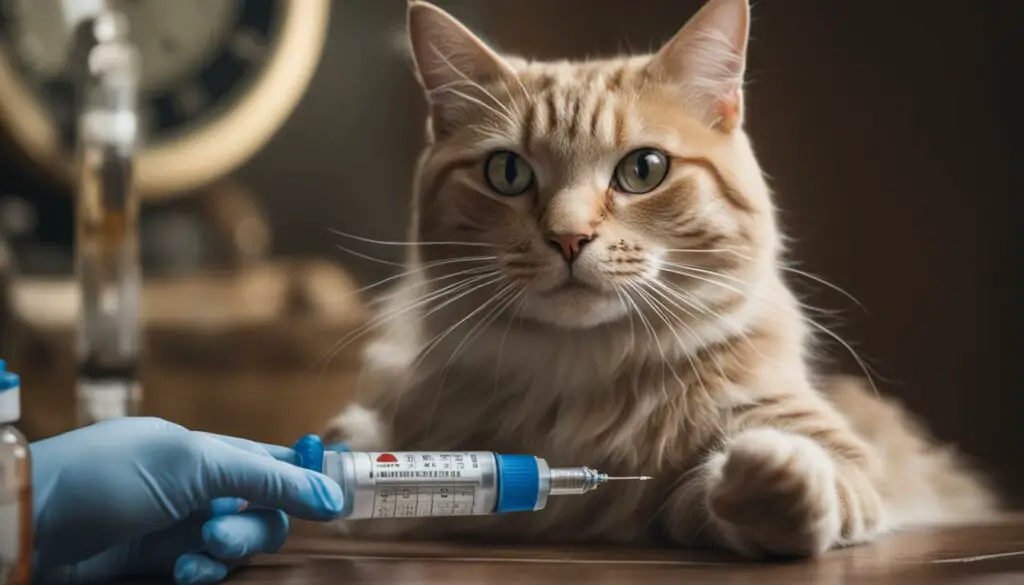
Expert Quote:
“Giving insulin ahead of time without veterinary guidance can have serious consequences for your cat’s health. Always consult with your veterinarian before making any changes to the insulin schedule.”
Managing Feline Diabetes
Proper management of feline diabetes involves more than just insulin administration. It requires a comprehensive approach that includes maintaining a consistent feeding schedule, monitoring blood glucose levels, and regular veterinary check-ups. By working closely with a veterinarian and following a tailored treatment plan, cat owners can effectively manage their furry friend’s diabetes.
One key aspect of managing feline diabetes is ensuring proper insulin dosing. The veterinarian will determine the appropriate dosage based on the cat’s individual needs and response to treatment. It is crucial to follow the prescribed dosage and administer insulin injections at the recommended times to maintain stable blood glucose levels.
In addition to insulin administration, diet plays a significant role in feline diabetes management. Feeding the cat a consistent and balanced diet can help regulate blood sugar levels and support overall health. The veterinarian may recommend a specialized diabetic cat food or provide guidance on crafting a suitable diet for the cat.
| Key Elements of Feline Diabetes Management |
|---|
| Regular insulin administration |
| Maintaining a consistent feeding schedule |
| Monitoring blood glucose levels |
| Regular veterinary check-ups |
| Balanced and appropriate diet |
It is important for cat owners to closely monitor their pet’s behavior and appetite and report any changes to the veterinarian. Regular check-ups and blood glucose testing can help identify any issues or adjustments needed in the treatment plan. Open communication with the veterinarian is essential for successful feline diabetes management.
Conclusion
Managing feline diabetes requires a multidimensional approach that encompasses insulin administration, diet, monitoring, and regular veterinary care. By following the veterinarian’s guidance, cat owners can effectively manage their pet’s diabetes and provide them with a happy and healthy life.
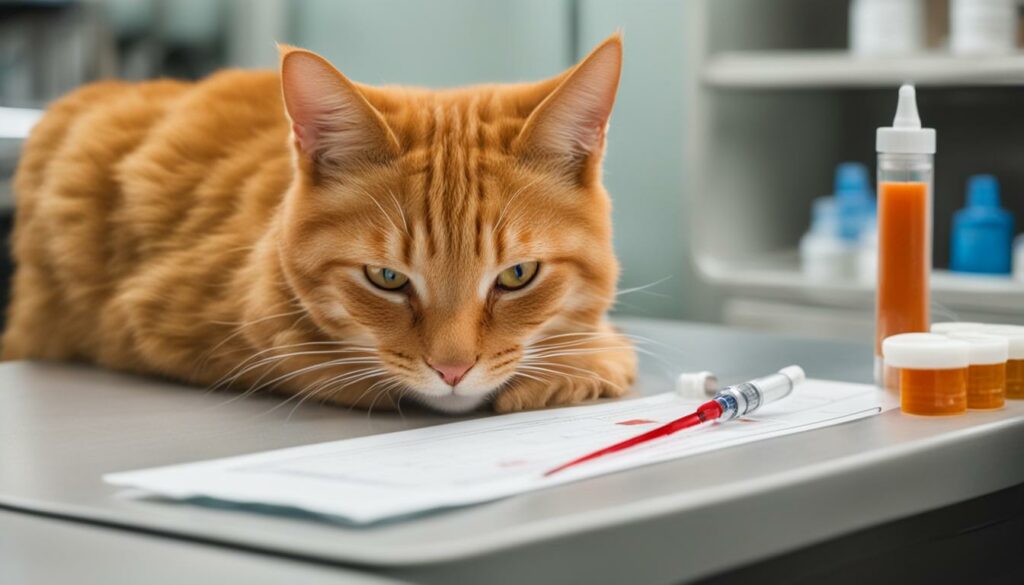
Expert Recommendations
When it comes to administering insulin to cats, it is important to follow expert recommendations to ensure the best possible outcome for your feline friend. Giving insulin doses earlier than scheduled can disrupt your cat’s blood sugar levels and potentially lead to hypoglycemia, a condition characterized by low blood sugar. Therefore, it is not recommended to give your cat insulin 2 hours early without consulting a veterinarian.
The proper timing of insulin doses is crucial for maintaining stable blood glucose levels in cats with diabetes. Deviating from the recommended schedule can pose health risks and complicate the management of feline diabetes. It is always best to work closely with a veterinarian who can provide individualized guidance based on your cat’s specific needs and response to treatment.
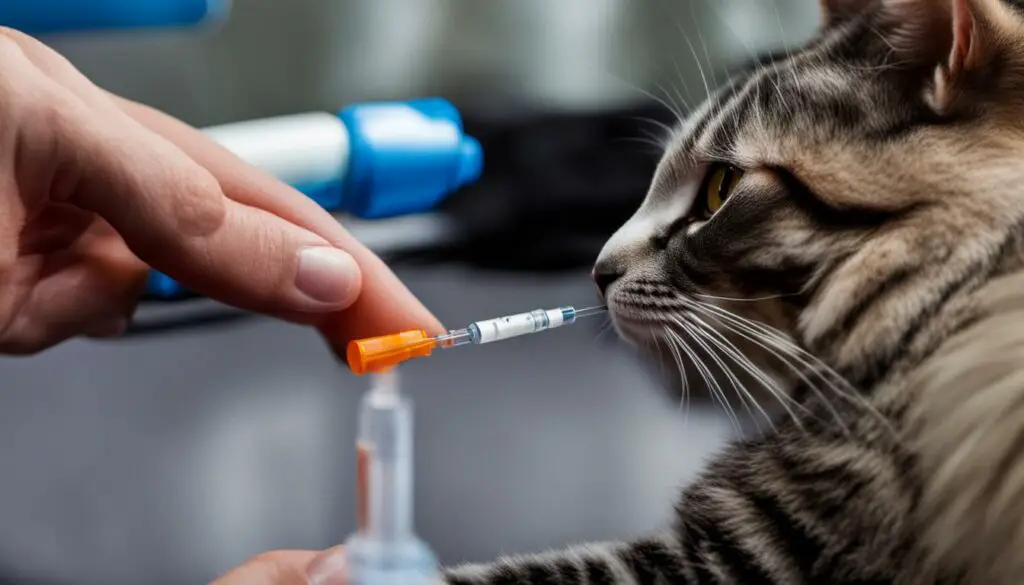
Consulting a Veterinarian is Key
Consulting a veterinarian is essential when it comes to administering insulin to cats. They can provide you with the proper instructions and guidance to ensure you are administering the correct dosage at the right time. Regular communication with your veterinarian is crucial for optimizing your cat’s health and well-being.
Tips for Administering Insulin to Cats
Administering insulin to cats can be a delicate process that requires patience and proper technique. Here are some tips to help you successfully administer insulin to your feline companion:
1. Distraction and Reward
Use a special treat or snack to distract and reward your cat during the insulin administration process. This can help create a positive association and make the experience more pleasant for both you and your cat.
2. Choosing the Right Injection Site
When administering insulin, choose an injection site with loose skin. The scruff of the neck or the areas around the flank are commonly used. Avoid areas where there is little or no loose skin, as this can make the injection more difficult and uncomfortable for your cat.
3. Practice Makes Perfect
If you’re new to administering insulin injections, consider practicing with a saline solution before administering actual insulin. This can help you become familiar with the process and gain confidence in handling the syringe and needle.
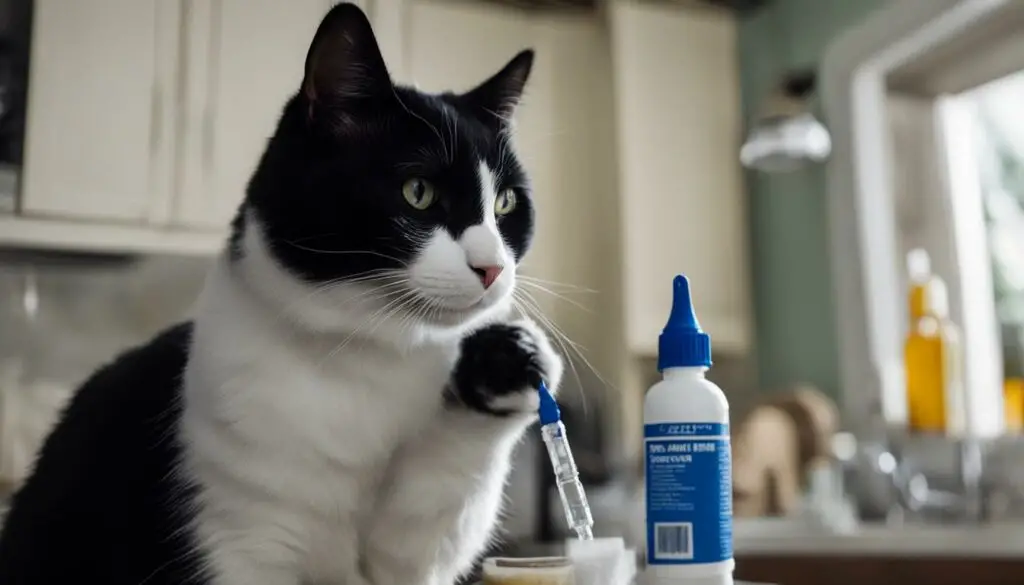
Remember, always consult your veterinarian for specific guidance on administering insulin to your cat. They can provide personalized instructions and address any concerns or questions you may have. With patience, practice, and proper communication with your veterinarian, you can successfully manage your cat’s insulin administration for their overall health and well-being.
Dealing with Missed Insulin Doses
When it comes to managing feline diabetes, adhering to the recommended insulin schedule is crucial. However, there may be instances where a cat misses an insulin dose. In such cases, it is important to handle the situation appropriately to minimize any potential risks or complications.
If a cat misses an insulin dose, it is generally recommended to wait until the next scheduled dose and administer the usual amount. While it may be tempting to give the missed dose immediately, it is crucial to avoid deviating from the recommended schedule without veterinary guidance. Giving insulin outside of the recommended timing or administering a double dose can disrupt the cat’s blood sugar levels and lead to complications.
Consulting a veterinarian is essential when dealing with missed insulin doses. They will provide specific instructions based on the cat’s individual needs and medical history. By seeking professional guidance, cat owners can ensure the appropriate course of action and minimize any potential risks associated with missed insulin doses.
Key Points:
- If a cat misses an insulin dose, wait until the next scheduled dose.
- Avoid giving insulin outside of the recommended schedule without veterinary guidance.
- Consult a veterinarian for specific instructions based on the cat’s individual needs.

Potential Risks of Improper Insulin Administration
Proper insulin administration is essential for managing feline diabetes effectively. However, improper administration can lead to various complications and undermine the cat’s glucose control. It is important to be aware of the potential risks associated with incorrect insulin dosing and timing.
One of the primary risks of improper insulin administration is hyperglycemia, which occurs when the cat’s blood sugar levels are consistently high. Hyperglycemia can lead to increased thirst, frequent urination, weight loss, and overall poor health. On the other hand, giving insulin doses too early or in excessive amounts can result in hypoglycemia, characterized by low blood sugar levels. Hypoglycemia can be life-threatening and cause weakness, disorientation, seizures, and even coma.
To avoid these risks, it is crucial to follow the veterinarian’s instructions for insulin dosing and timing. Regular monitoring of the cat’s blood glucose levels is also essential for detecting any deviations and adjusting the treatment plan accordingly. Communication with the veterinarian is key to ensuring proper insulin administration and managing feline diabetes effectively.

Table: Risks of Improper Insulin Administration
| Risks | Description |
|---|---|
| Hyperglycemia | Consistently high blood sugar levels leading to increased thirst, frequent urination, weight loss, and poor health. |
| Hypoglycemia | Low blood sugar levels that can be life-threatening, causing weakness, disorientation, seizures, and coma. |
Importance of Regular Monitoring
Regular monitoring is a crucial aspect of managing feline diabetes. By closely observing your cat’s blood glucose levels, behavior, appetite, and weight, you can make informed decisions about their insulin dosing and treatment plan. Monitoring allows you to detect any changes or abnormalities early on and address them promptly, ensuring the best possible management of your cat’s diabetes.
Regular blood glucose testing is essential for understanding how well your cat’s diabetes is controlled. This can be done at home using a glucose meter specifically designed for cats. By regularly measuring their blood glucose levels, you can adjust the insulin dosing as necessary to maintain stable blood sugar levels.
In addition to blood glucose testing, it’s important to pay attention to your cat’s behavior and appetite. Changes in behavior, such as increased or decreased activity levels, excessive thirst, or frequent urination, can indicate fluctuating blood sugar levels. Similarly, changes in appetite, including increased or decreased eating, may also require adjustments to the insulin dosing or treatment plan.
Benefits of Regular Monitoring
- Early detection of changes in blood glucose levels
- Ability to adjust insulin dosing as needed
- Prevention of complications associated with poorly controlled diabetes
- Improved overall management of feline diabetes
By regularly monitoring your cat’s diabetes, you can work closely with your veterinarian to ensure optimal feline diabetes management. With their guidance and your dedication to monitoring, you can provide the best possible care for your cat and help them live a happy, healthy life.
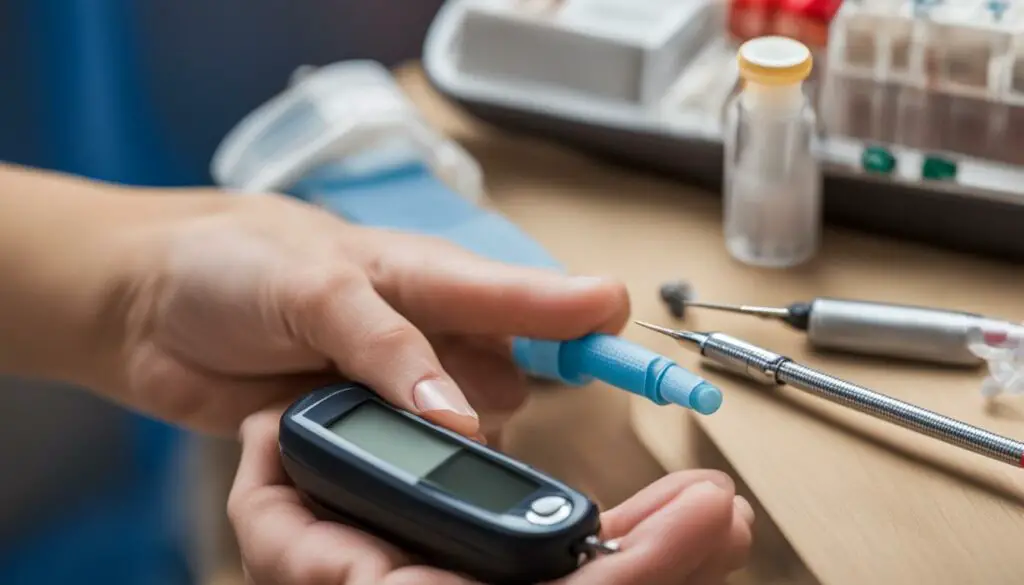
Table: Blood Glucose Levels
| Glucose Level | Interpretation |
|---|---|
| Less than 70 mg/dL | Hypoglycemia (low blood sugar) |
| 70-150 mg/dL | Normal blood sugar level |
| 150-250 mg/dL | Acceptable blood sugar level |
| More than 250 mg/dL | Hyperglycemia (high blood sugar) |
Communication with the Veterinarian
Effective communication with the veterinarian plays a crucial role in managing cat insulin administration and feline diabetes. Regular check-ups and discussions about the cat’s response to treatment, changes in behavior or appetite, and any concerns or questions are essential for optimizing the cat’s health and well-being. By maintaining open lines of communication, cat owners can ensure that their furry companions receive the best possible care and attention.
During veterinary appointments, it is important to provide detailed information about the cat’s insulin dosing and any challenges or changes observed. This includes discussing the timing of insulin administration, the cat’s response to treatment, and any difficulties encountered during the administration process. The veterinarian may also request blood glucose monitoring records to evaluate the cat’s glucose control and make any necessary adjustments to the insulin dosage or schedule.
Additionally, cat owners should not hesitate to ask questions or seek clarification on any aspect of feline diabetes management. This can include inquiries about insulin storage and handling, techniques for administering insulin, or advice on managing other aspects of feline diabetes, such as diet and exercise. The veterinarian is a valuable resource in providing guidance, support, and personalized recommendations to ensure the cat’s diabetes is effectively managed.
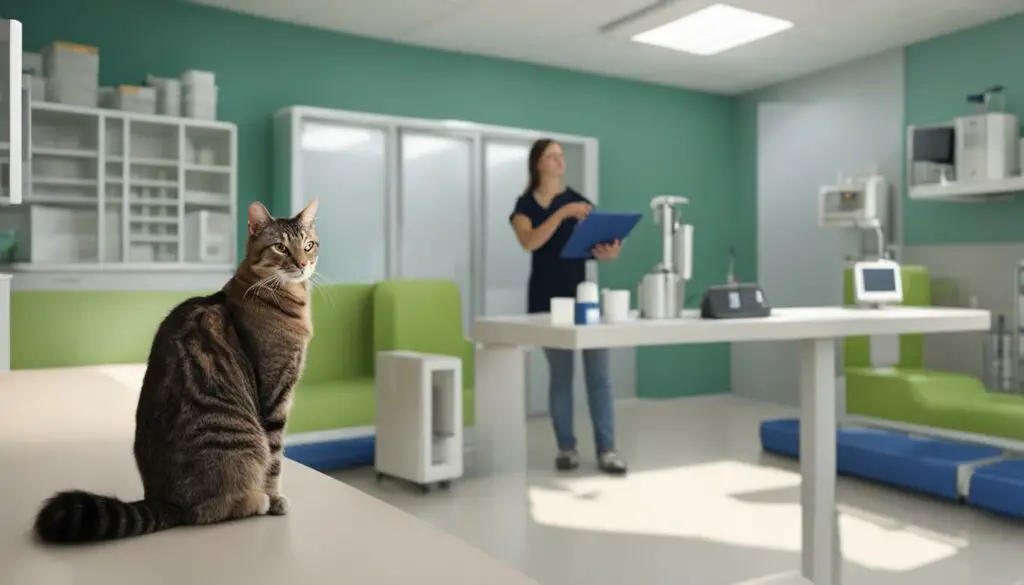
Key Points:
- Regular communication with the veterinarian is crucial for managing cat insulin administration and feline diabetes.
- During veterinary appointments, provide detailed information about insulin dosing and any observed changes or difficulties.
- Ask questions and seek clarification on any aspect of feline diabetes management to optimize the cat’s health and well-being.
Resources for Diabetes Management Support
Managing feline diabetes can be a challenging task for cat owners. Fortunately, there are resources available to provide support and guidance throughout the journey of insulin administration and feline diabetes management.
One valuable resource is online communities and forums dedicated to feline diabetes. These platforms allow cat owners to connect with others who are going through similar experiences. It provides an opportunity to share stories, ask questions, and seek advice from people who understand the unique challenges of managing diabetes in cats.
Additionally, there are educational materials available that provide comprehensive information on cat insulin administration and feline diabetes management. These resources often include step-by-step guides, tips and tricks, and expert recommendations to help cat owners navigate the complexities of administering insulin and maintaining proper glucose control.
It is important to utilize these resources and engage in ongoing learning to stay up-to-date with the latest advancements in feline diabetes management. By accessing these valuable tools, cat owners can gain confidence in their ability to effectively care for their diabetic feline companions.
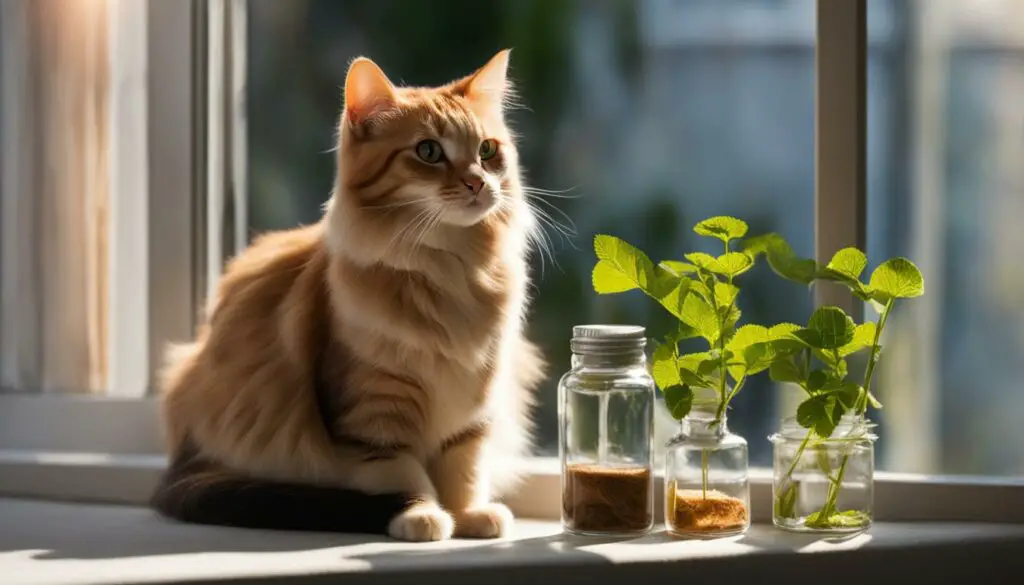
Online Communities and Forums
| Website | Description |
|---|---|
| www.felinediabetesforum.com | A dedicated online forum for cat owners to share experiences, ask questions, and receive support regarding feline diabetes management. |
| www.catinsulin.com | An online community that focuses specifically on cat insulin administration, providing resources and advice for cat owners. |
| www.diabetesmewow.com | A website that offers a supportive community and educational resources to help cat owners manage feline diabetes effectively. |
Educational Materials
- Understanding Feline Diabetes: A Comprehensive Guide – A book that covers everything cat owners need to know about feline diabetes, including insulin administration, diet management, and glucose monitoring.
- Feline Diabetes Management 101: Tips and Tricks for Success – An informative booklet that provides practical advice and strategies for managing feline diabetes, written by veterinary experts.
- Insulin Administration Made Easy: A Step-by-Step Guide for Cat Owners – A comprehensive manual that simplifies the process of administering insulin to cats, complete with detailed illustrations and troubleshooting tips.
By utilizing these resources, cat owners can gain the knowledge and support needed to effectively manage feline diabetes and ensure the well-being of their furry companions.
Conclusion
In summary, administering insulin to cats with diabetes requires careful consideration of timing and adherence to the recommended schedule. While there may be instances where giving insulin 2 hours early is necessary, it is crucial to consult a veterinarian for guidance. The management of feline diabetes involves regular communication with the veterinarian, monitoring blood glucose levels, and maintaining a consistent treatment plan.
Proper feline diabetes management also extends beyond insulin administration. It encompasses maintaining a consistent feeding schedule, monitoring the cat’s behavior and appetite, and regular veterinary check-ups. By working closely with a veterinarian and following their instructions, cat owners can effectively manage their pet’s diabetes and ensure their overall health and well-being.
For cat owners seeking additional support and information, there are online resources available such as communities, forums, and educational materials. These resources can provide valuable insights, tips, and support for navigating the complexities of insulin administration and feline diabetes management. Utilizing these resources can help cat owners feel more confident in their ability to care for their diabetic cat.
In conclusion, by following the recommended insulin timing, maintaining open communication with a veterinarian, and utilizing available resources, cat owners can provide the best possible care for their feline companions with diabetes. With a dedicated approach to management and a partnership with a trusted veterinarian, cats with diabetes can lead happy and healthy lives.
FAQ
Can I give my cat insulin 2 hours early?
Giving insulin to a cat too early can lead to hypoglycemia, a condition characterized by low blood sugar. It is important to follow the recommended insulin schedule and avoid giving insulin doses ahead of time without consulting a veterinarian.
What are the risks of giving insulin too early?
Giving insulin to a cat too early can result in hypoglycemia, which can cause weakness, lethargy, and even coma. It is crucial to adhere to the recommended insulin timing to maintain stable blood sugar levels in cats with diabetes.
What are the guidelines for insulin timing in cats?
It is generally recommended to administer insulin injections to cats twice a day, approximately 12 hours apart. Deviating from this schedule without proper guidance can disrupt the cat’s glucose control and pose health risks.
Can I adjust the insulin schedule for my cat?
Adjusting the insulin schedule for cats should always be done under the guidance of a veterinarian. The timing of insulin doses or the dosage amount may be adjusted based on the cat’s response to treatment and blood glucose levels.
What should I consider when giving insulin early?
Giving insulin early should only be done under the guidance of a veterinarian, considering the cat’s individual needs, medical history, and response to treatment. It is important to follow professional advice to prevent complications.
How can I effectively manage feline diabetes?
Proper management of feline diabetes involves following the recommended insulin schedule, maintaining a consistent feeding schedule, monitoring blood glucose levels, and regular veterinary check-ups.
Are there any expert recommendations for insulin administration to cats?
Experts recommend following the recommended insulin schedule for cats and avoiding giving insulin doses earlier than scheduled. Consulting with a veterinarian is crucial for individualized guidance on insulin administration.
What are some tips for administering insulin to cats?
Some tips for successful insulin administration include using a special treat or snack to distract and reward the cat, choosing a suitable injection site with loose skin, and practicing with saline solution before administering actual insulin injections.
What should I do if my cat misses an insulin dose?
If a cat misses an insulin dose, it is generally recommended to wait until the next scheduled dose and administer the usual amount. Giving insulin outside of the recommended schedule or giving a double dose can have adverse effects on the cat’s blood sugar levels. Consult a veterinarian for guidance in such situations.
What are the potential risks of improper insulin administration?
Improper insulin administration can lead to complications in cats with diabetes, including hyperglycemia (high blood sugar), hypoglycemia (low blood sugar), and poor glucose control. Following the veterinarian’s instructions for insulin dosing and timing is crucial for managing feline diabetes effectively.
Why is regular monitoring important in feline diabetes management?
Regular monitoring of a cat’s blood glucose levels allows for adjustments in insulin dosing or treatment plans as needed. This involves periodic blood glucose testing, observing changes in behavior and appetite, and tracking weight gain or loss.
How important is communication with the veterinarian for insulin administration?
Effective communication with the veterinarian is key to successful insulin administration and management of feline diabetes. Regular check-ups and discussions about the cat’s response to treatment, changes in behavior or appetite, and any concerns or questions are essential for optimizing the cat’s health and well-being.
Are there resources available to support cat owners in diabetes management?
Online communities, forums, and educational materials provide information, tips, and support for cat owners caring for cats with diabetes. Utilizing these resources can help owners navigate the complexities of insulin administration and feline diabetes management.

